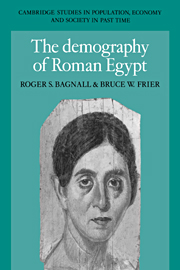Book contents
- Frontmatter
- Contents
- List of figures
- List of tables
- Foreword
- Preface
- A note on references and abbreviations
- 1 The census returns
- 2 The census returns as demographic evidence
- 3 Households
- 4 Female life expectancy
- 5 Male life expectancy and the sex ratio
- 6 Marriage
- 7 Fertility
- 8 Migration
- 9 Conclusion
- Catalogue of census declarations
- Catalogue of census declarations Supplement
- Appendixes
- Bibliography
- Index
- Cambridge Studies in Population, Economy and Society in Past Time
5 - Male life expectancy and the sex ratio
Published online by Cambridge University Press: 06 January 2010
- Frontmatter
- Contents
- List of figures
- List of tables
- Foreword
- Preface
- A note on references and abbreviations
- 1 The census returns
- 2 The census returns as demographic evidence
- 3 Households
- 4 Female life expectancy
- 5 Male life expectancy and the sex ratio
- 6 Marriage
- 7 Fertility
- 8 Migration
- 9 Conclusion
- Catalogue of census declarations
- Catalogue of census declarations Supplement
- Appendixes
- Bibliography
- Index
- Cambridge Studies in Population, Economy and Society in Past Time
Summary
The female age distribution in Roman Egypt is easily interpreted through the Coale-Demeny model life tables. By contrast, the male age distribution presents greater difficulties, and reconstruction of male mortality is much more uncertain. The census returns preserve the ages of 350 males. The raw data are in Table A, from which derives the summary in Table 5.1.
Although the male figures also clearly point to a population with very high mortality, they are apparently somewhat disturbed, as will emerge below, by external influences on the reporting of male ages. The resulting distortion, although not great, suffices to impede an accurate estimate of male mortality. The results in this chapter are therefore more tentative than those in Chapter 4.
This chapter proceeds circuitously to explore the male age distribution and to bring out the problems with it. We begin by examining the overall sex ratio in the returns, then the age-specific sex ratio, and then a possible male life table. We conclude with broader observations on mortality in Roman Egypt.
The sex ratio
The sex ratio expresses the relative numbers of males and females in a population. By convention, it is stated as the number of males per hundred females. In populations of contemporary more developed countries, females outnumber males because female life expectancy is much higher than male; for example, in 1985 the United States had a sex ratio of 94.8 males per hundred females. But in India, where female life expectancy has historically lagged behind that of males, the sex ratio is reversed; in 1971, for instance, India had 107.5 males per hundred females.
- Type
- Chapter
- Information
- The Demography of Roman Egypt , pp. 91 - 110Publisher: Cambridge University PressPrint publication year: 1994



